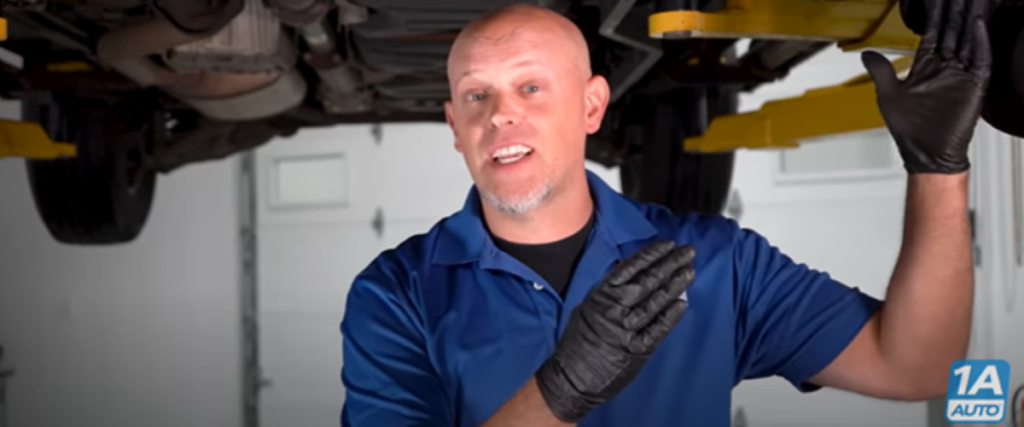If you hear a clunking or banging noise from the front or rear of your car, in this article and video we show what parts to check. It’s common for worn wheel bearings, tie rods, and ball joints to cause this kind of problem, but control arm bushings are an often overlooked part. You’ll find out bad control arm bushing symptoms, how to check and replace bushings at the front and rear, how to check your front and rear for this problem, and more with these tips.
How to Diagnose a Clunking Noise from the Front or Rear of Your Car

Check the Wheel Hubs, Tie Rods, and Ball Joints for a Clunking Noise
Lift and secure the vehicle with a jack and jack stands
Grab the left and right side of the tire, at the 3 and 9 o’clock positions, and press it in and out, feeling for excessive looseness or play.
Grab the top and bottom of the tire, at the 12 and 6 o’clock positions, and press it in and out, feeling for excessive looseness or play.
This is a sign of an issue with the wheel bearings, tie rods, or ball joints
More tips on checking the wheel hub
More tips on checking the ball joints and tie rods
If you find no issue with these parts, there might be an issue with the control arm bushings.
Bad Control Arm Bushing Symptoms
Bad control arm bushing symptoms include:
- Dry-rotted bushings
- Cracked, split, or torn bushings
- Clunking noises
- Misaligned vehicle
- Excessive looseness or “play”
- Early tire wear
Note: Worn rear control arm bushings will have similar symptoms to worn front control arm bushings. You might hear a clunking or banging sound, wobbly steering, or problems with the wheel alignment.
How to Check and Diagnose Bad Control Arm Bushings
Check for Excessive Movement

You might find no visible signs of wear or damage, but this doesn’t mean the bushings are in good condition. You can pry from the control arm with a pry bar to check for excessive movement.
A control arm bushing with excessive movement can also cause alignment issues and wear your tires out early.
Check for Damage like Cracking

Check the control arm bushing for signs of wear or damage, like cracking. The rubber can dry up and start to separate, reducing the bearings performance and causing symptoms like cracking and dry-rotting.
If you find cracking, like in this example, the bushings will need replacing.
How to Replace Bad Control Arm Bushings
Tip: Install the Control Arms Correctly
A control arm bushing could wear out early from improper installation. If the control arm is not angled properly when the bolt or nut is torqued down, extra load on the bushing can cause it to tear, which will wear it out faster.
General steps for replacing bad control arm bushings
- Remove the Tire
Loosen the lug nuts with the tire on the ground, lift and secure the vehicle with a jack and jack stands, and remove the lug nuts and tire.
- Remove the Bushing Nut
Remove the main nut from the bushing
- Remove Any Clips or Retainers
Remove any panels or clips from the control arm interfering with access to the bolt
- Remove the Bolts from the Bushing
Remove the nuts and bolts holding the bushing in place
- Remove the Bushing
Tap the worn control arm bushing off with a hammer
- Install the New Bushing
When putting the new control arm bushing on, use a mallet or a dead blow. This will slide it into place and prevent damage.
- Tighten the Bolts to the Bushing
Tighten the nuts and bolts that secure the bushing into position and torque them to manufacturer specifications.
- Jack Up the Control Arm
Jack up underneath the lower control arm to simulate ride height.
- Torque the Bolt and Lower the Suspension
Tighten and torque the bushing’s bolt to manufacturer specifications. Lower the front suspension
- Replace Any Clips or Retainers
Replace any panels or clips removed
- Reinstall the Tire
Put the wheel into place, tighten the lug nuts preliminarily, lower the vehicle to the ground, torque the lug nuts to manufacturer specification in a star or crossing pattern
- Get a Wheel Alignment
Get a professional wheel alignment after replacing the worn bushing
General Steps to Replace a Rear Control Arm Bushing
For rear control arm bushings, depending on the style you might have to press the bushing out with special tools. In the example in this article’s featured video at 4:12, we remove the components in the way, like the brake lines or ABS wire, remove the bolts from the trailing arm and tip it down with a pry bar, and hammer out the rear bushing with an air hammer. Then we sand down the surface area to make the installation go smoother, mark on the bushing how far it needs to be pressed in, add a little grease to the bushing, and hammer it in with a dead blow hammer and old bushing. Then we reinstall the bolts and torque it to manufacturer specifications, and reinstall the other parts removed.
Have the vehicle aligned at a shop professionally afterwards to prevent early tire wear.
How-to Videos for Your DIY Car Repairs
Learn to fix parts on different models and pick up general tips and more with our how-to videos. You’ll learn expert advice and instructions from our mechanics to empower your to do your own repairs.
Shop Quality Auto Parts

Related Content
- DIY Alignment: How to Do a Wheel Alignment at Home
- Should I Replace Both the Inner and Outer Tie Rods?
- Should I Replace the Ball Joint or the Entire Control Arm Assembly?
- What Happens When a Wheel Bearing Goes Out?
- Should I Replace the Wheel Bearing or the Entire Hub?
- How to Check Tire Tread for Wear

